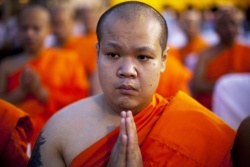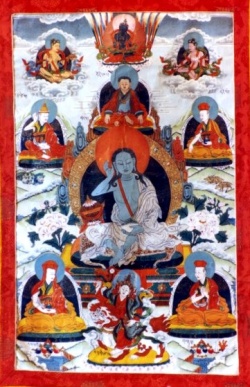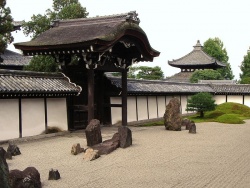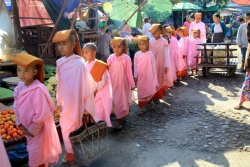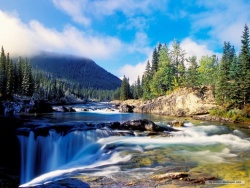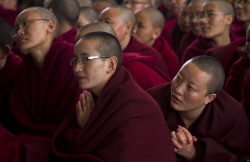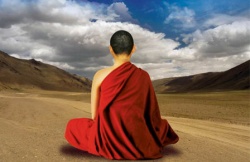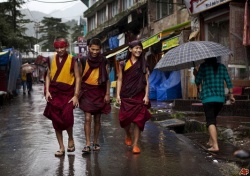The Essence of the ''Medicine King''
CONCERNING the general meaning of this chapter called the “Medicine King”: the “Medicine King” chapter is in the seventh volume and is the twenty-third of the twenty-eight chapters that make up the Lotus Sutra.
The first volume of the sutra contains two chapters, the “Introduction” chapter and the “Expedient Means” chapter. The “Introduction” chapter serves as a prologue to the entire twenty-eight chapters.
The eight chapters beginning with “Expedient Means” and continuing through “Prophecies” are concerned primarily with clarifying how persons of the two vehicles can attain Buddhahood, and secondarily with clarifying how bodhisattvas and ordinary people can attain Buddhahood.
The following five chapters, the “Teacher of the Law,” “Treasure Tower,” “Devadatta,” “Encouraging Devotion,” and “Peaceful Practices” chapters, explain how the teachings set forth in the preceding eight chapters are to be carried out by ordinary people in the latter age.
The ensuing “Emerging from the Earth” chapter serves as an introduction to the “Life Span” chapter. The subsequent twelve chapters, numbering from the “Distinctions in Benefits” chapter on, serve primarily to explain how the doctrines set forth in the “Life Span” chapter are to be carried out by ordinary people in the latter age, and secondarily to explain how those set forth in the eight chapters from “Expedient Means” on are to be carried out.
The “Medicine King” chapter, therefore, is a chapter that explains how one ought to carry out the teachings both of the eight chapters beginning with “Expedient Means” and of the “Life Span” chapter.
This chapter, the “Medicine King,” contains ten analogies, the first of which is the analogy of the great ocean. I will begin by explaining this analogy in outline form. In the southern continent of Jambudvīpa, there are 2,500 rivers; in the western continent of Godaniya, there are 5,000 rivers. In all the four continents, there are a total of 25,900 rivers. Some of these rivers are forty ri in length, some a hundred ri, some only one ri, one chō, or one fathom. However, concerning the matter of depth, not one of these rivers can match the great ocean.
Among all the sutras, such as the Flower Garland Sutra, the Āgama sutras, the Correct and Equal sutras, the Wisdom, Profound Secrets, Amida, Nirvana, Mahāvairochana, Diamond Crown, Susiddhikara, and Secret Solemnity sutras, all the sutras preached by the Thus Come One Shakyamuni, p.92 all the sutras preached by the Thus Come One Mahāvairochana, all the sutras preached by the Thus Come One Amida, all the sutras preached by the Thus Come One Medicine Master, and all the sutras preached by the various Buddhas of the three existences of past, present, and future—among all these sutras, the Lotus Sutra stands foremost. Thus these other sutras are analogous to the large rivers, middle-sized rivers, and small rivers, while the Lotus Sutra is likened to the great ocean.
The ocean possesses ten virtues, in which it surpasses the rivers. First, the ocean gradually becomes deeper, which is not true of rivers. Second, the ocean refuses to house corpses, which is not true of rivers. Third, the ocean obliterates the names of the various rivers that flow into it, while rivers retain their names. Fourth, the ocean’s taste is the same everywhere, while this is not true of rivers. Fifth, the ocean contains various treasures that are not found in rivers. Sixth, the ocean is extremely deep, which is not true of rivers. Seventh, the ocean is boundless in breadth, which rivers are not. Eighth, the ocean houses creatures of great size, which is not true of rivers. Ninth, the ocean has tides that ebb and flow, but rivers do not, and tenth, the ocean absorbs the waters of torrential rains or huge rivers without ever overflowing, but this is not true of rivers.
The Lotus Sutra likewise has ten virtues, while the other sutras have ten faults. In the case of this sutra, the benefits gained from it increase in depth and bounty, and they continue down to the fiftieth person who hears of it. In the case of the other sutras, however, there is no benefit to be gained even by the first person who hears them, much less by the second, third, or fourth person, and so on down to the fiftieth person.
Though rivers may be deep, their depth cannot match even the shallow places of the ocean. And though the various other sutras may claim that because of a single character, a single phrase, or the ten meditations1 they encompass evil people who have committed the ten evil acts or the five cardinal sins, such benefits cannot match those gained by the fiftieth person who hears a single character or a single phrase of the Lotus Sutra and responds with joy.
In the case of the Lotus Sutra, just as the ocean refuses to house corpses, those who slander the Law by turning against the Lotus Sutra will be cast out by the sutra, even though in other respects they may be people of extreme goodness. And how much more so will this be true in the case of evil persons who, in addition to their other evil acts, slander the Law! Though one may speak slanderously of the other sutras, if one does not turn against the Lotus Sutra, one is certain to attain the Buddha way. But though one may put faith in all the other sutras, if one turns against the Lotus Sutra, one will invariably fall into the great citadel of the Avīchi hell.
I move now to the eighth virtue of the ocean, the fact that it can house creatures of great size. And we find that in the ocean there are huge fish such as the makara.2 The place called the hell of incessant suffering measures eighty thousand yojanas in total length and breadth. But when a person falls into the hell of incessant suffering by committing the five cardinal sins, this person alone is sufficient to fill it up completely.3 Thus we know that the inhabitants of this hell, persons who have committed the five cardinal sins, are beings of very great size.
In the other sutras, which we have likened to small rivers or large rivers, no makara fish are to be found. However, in the great ocean that is the Lotus Sutra, they do exist. And in like p.93manner, the other sutras do not in fact state that persons who commit the five cardinal sins are capable of attaining the Buddha way. Or even if the sutras do state this, in fact the true principle has yet to be revealed in them.
Therefore, the Great Teacher T’ien-t’ai Chih-che, who had memorized all the sacred teachings of the Buddha’s lifetime, says in his commentary on the Lotus Sutra: “The other sutras only predict Buddhahood for bodhisattvas, but not for persons of the two vehicles. They only predict it for the good, but not for the evil; . . . This sutra predicts Buddhahood for all.”4 But I will not go into details on this matter.
Second is the analogy of mountains. The sutra says that, among the Ten Treasure Mountains and all the other mountains, Mount Sumeru is foremost. The Ten Treasure Mountains are: first, the Snow Mountains; second, Mount Fragrant; third, Mount Khadira; fourth, the Mountain of Immortals and Sages; fifth, Mount Yugamdhara; sixth, Horse Ear Mountain; seventh, Mount Nimindhara; eighth, Mount Chakravada; ninth, the Mountain of Past Wisdom; and tenth, Mount Sumeru.
The first nine of these ten mountains are analogous to the various other sutras, which are like ordinary mountains. Each of these mountains contains treasures. But Mount Sumeru contains a multitude of treasures, treasures superior to those of the other mountains. For example, it is like Jambunada gold,5 to which ordinary gold cannot compare.
The Flower Garland Sutra has its teaching that “the phenomenal world is created by the mind alone”; the Wisdom sutras have their eighteen kinds of non-substantiality; the Mahāvairochana Sutra has its fivefold meditation for attaining Buddhahood, and the Meditation Sutra has its doctrine of rebirth in the Pure Land. But the Lotus Sutra’s teaching of the attainment of Buddhahood in one’s present form surpasses all of these.
Mount Sumeru is golden in color. Every creature that comes to this mountain, whether ox or horse, human or heavenly being, bird or any other being, inevitably loses its original color and takes on the golden color of the mountain. This is not true of any of the other mountains. In the same manner, the various other sutras, when placed beside the Lotus Sutra, lose their original color. They are like black objects that, when exposed to the light of the sun or the moon, lose their color. So the teachings concerning rebirth in another land or the attainment of Buddhahood that color these other sutras inevitably lose their meaning when exposed to the light of the Lotus Sutra.
Third is the analogy of the moon. Among the various stars, some can light an area of no more than half a ri, some an area of no more than one ri, some an area of no more than eight ri or sixteen ri. But the moon can light an area of over eight hundred ri. Thus, although the various stars have their light, it cannot equal that of the moon.
Even if we were to assemble a hundred, a thousand, ten thousand, or a million stars, as well as all the stars from the world of the four continents, from a major world system, and from all the worlds of the ten directions, their light would not equal the light of a single moon. How then could the light of only one star equal the light of the moon?
Similarly, though we gather together all the various sutras, such as the Flower Garland Sutra, the Āgama sutras, the Correct and Equal sutras, the Wisdom, Nirvana, Mahāvairochana, and Meditation sutras, they could never equal even a single character of the Lotus Sutra.
Within the minds of all human beings, there exist the three categories of illusions of thought and desire, of illusions innumerable as particles of dust p.94and sand, and of illusions about the true nature of existence, as well as karma created by the ten evil acts or the five cardinal sins—all of which are like a dark night. The Flower Garland and the other various sutras are like stars in this dark night, while the Lotus Sutra is like the moon. For those who have faith in the Lotus Sutra, but whose faith is not deep, it is as though a half moon were lighting the darkness. But for those who have profound faith, it is as though a full moon were illuminating the night.
On a night when there is no moon, but only the light of the stars, strong men or robust individuals may walk abroad, but elderly people and women will find it impossible to do so. But when there is a full moon, even women and the elderly may walk about anywhere they please, proceeding to a banquet or going to meet others. Similarly, in the various sutras it is said that bodhisattvas and ordinary persons of great capacity can attain enlightenment. But for persons of the two vehicles, ordinary people, women, and evil men, or people in the latter age who are elderly and lazy and do not observe the precepts, no assurance is given that they can ever attain rebirth in the pure land or achieve Buddhahood. This is not so of the Lotus Sutra, however. There even persons of the two vehicles, women, and evil men are assured of becoming Buddhas, to say nothing of bodhisattvas and ordinary persons of great capacity.
Again, the moon shines more brightly around dawn than it does in the early evening, and is more luminous in autumn and winter than in spring and summer. In a similar fashion, the Lotus Sutra is even more effective in bringing benefit to living beings in the Latter Day of the Law than it is during the two thousand years that make up the Former and Middle Days of the Law.
Question: What passages of proof can you offer?
Answer: The truth is plain to see. In addition, this chapter later states as follows: “After I have passed into extinction, in the last five-hundred-year period you must spread it [the Lotus Sutra) abroad widely throughout Jambudvīpa and never allow it to be cut off.”6 This passage from the sutra, which states that it must be widely spread throughout Jambudvīpa, the southern continent, when two thousand years have passed, expresses the same meaning as the third analogy of the moon. The Great Teacher Kompon, also known as the Great Teacher Dengyō, was referring to this idea when he stated in his commentary: “The Former and Middle Days are almost over, and the Latter Day is near at hand. Now indeed is the time when the one vehicle of the Lotus Sutra will prove how perfectly it fits the capacities of all people.”7
The benefits conferred by the Lotus Sutra surpass those of the various other sutras even during the thousand years of the Former Day of the Law and the thousand years of the Middle Day of the Law. But when the spring and summer of the two thousand years of the Former and Middle Days are over, and the autumn and winter of the Latter Day of the Law have come, then the light of this moon will shine more brightly than ever.
Fourth is the analogy of the sun. When the moon appears in the sky where the stars are shining, although its light surpasses that of the stars, the stars do not actually lose their light. But when the sun appears, not only do the stars lose their light, but the moon, too, is deprived of its light and loses its glow.
The sutras preached before the Lotus Sutra are like the stars, the theoretical teaching of the Lotus Sutra is like the moon, and the “Life Span” chapter is p.95like the sun. When the “Life Span” chapter makes its appearance, then the moon of the theoretical teaching cannot equal it, to say nothing of the stars that are the previous sutras.
During the night, the time of the stars and the moon, people do not pursue their occupations. But when dawn comes, they invariably go about their various tasks. Similarly, while the earlier sutras or the theoretical teaching of the Lotus Sutra prevail, it will be difficult for people to free themselves from the sufferings of birth and death. But once the “Life Span” chapter of the essential teaching makes its appearance, then people are certain to free themselves from the sufferings of birth and death.
I will omit a discussion of the other six of the ten analogies.
In addition to these ten, there are many other analogies in this chapter. Among them is that of a traveler who finds a ship when he wishes to make a crossing. The meaning of this analogy is that, in the sea of the sufferings of birth and death, the sutras preached before the Lotus Sutra are like rafts or small boats. Although they can carry people from one shore in the realm of birth and death to another shore in that same realm, they are incapable of carrying them across the sea of birth and death to the distant shore of Perfect Bliss.8
These sutras are like the small boats of our world that can go from Kyushu to the Bando region, or from Kamakura to Enoshima,9 but cannot go as far as China. A China ship, on the other hand, is fully capable of going all the way from Japan to China without difficulty.
Again, there is the analogy that reads, “like the poor finding riches.” The lands represented by the sutras preached before the Lotus Sutra are impoverished lands, and their inhabitants are like hungry spirits. The Lotus Sutra, on the other hand, is a veritable mountain of riches, and its inhabitants are wealthy.
Question: When you say that the lands of the sutras preached before the Lotus Sutra are impoverished lands, what passage of scripture are you referring to?
Answer: The “Bestowal of Prophecy” chapter [of the Lotus Sutra) states, “Suppose that someone coming from a land of famine should suddenly encounter a great king’s feast.”
Concerning rebirth in the pure land and the attainment of Buddhahood by women, a passage from the sutra has this to say: “If in the last five-hundred-year period after the Thus Come One has entered extinction there is a woman who hears this sutra and carries out its practices as the sutra directs, when her life here on earth comes to an end, she will immediately go to the World of Peace and Delight where the Buddha Amida dwells surrounded by the assembly of great bodhisattvas and there will be born seated on a jeweled seat in the center of a lotus blossom.”10
Question: Why do this sutra and this chapter in the sutra make a particular point of discussing rebirth in the pure land by women?
Answer: The Buddha’s intentions are difficult to fathom, and the significance of this matter is difficult to determine. But if I were to venture a guess, I would say that it is because women are looked upon as the root of various errors and the source of the downfall of the nation. Therefore, in both Buddhist and non-Buddhist scriptures, there are many prohibitions laid down with regard to women. Among these, for example, are the three obediences set forth in the non-Buddhist scriptures. The “three obediences” means to obey three times and refers to the fact that, when a woman is young, she must obey her parents; when she p.96marries, she must obey her husband; and in old age, she must obey her son. She is thus confronted with these three obstacles and cannot conduct herself freely in the world.
If we turn to the Buddhist scriptures, we find that they speak of the five obstacles. Of these five obstacles that confront women, the first is the fact that, in the course of being reborn again and again in the six paths, they cannot, like men, ever be reborn as the great heavenly king Brahmā. Second, they can never be reborn as the heavenly king Shakra. Third, they cannot be reborn as a devil king. Fourth, they cannot be reborn as a wheel-turning king. And fifth, they must remain forever within the six paths, unable to emerge from the threefold world and become a Buddha. (This passage is found in the Meditation Outshining the Sun and Moon Sutra.)11 The Silver-Colored Woman Sutra has this to say: “Even if the eyes of the Buddhas of the three existences were to fall to the ground, no woman in any of the realms of existence could ever attain Buddhahood.”
Ordinary human beings though they are, worthy rulers and sages do not tell falsehoods. Thus Fan Yü-ch’i presented his head to Ching K’o, and Prince Chi-cha hung his sword on the grave of the lord of Hsü. They did these things so as not to go against their promises or be guilty of uttering falsehoods. And if such men do not utter falsehoods, how much more is this true of voice-hearers, bodhisattvas, or Buddhas!
In the past, when the Buddha was still an ordinary man and was practicing the teachings of the Hinayana sutras, he undertook to observe the five precepts. And among these five, the fourth is that one must never lie. He firmly observed this precept. Thereafter, even though it meant losing his property or his life, he never violated it.
When he was practicing the teachings of the Mahayana sutras, he observed the ten major precepts, and among these ten major precepts, the fourth is that one must never lie. He faithfully observed this precept without once violating it throughout countless kalpas, until in the end, through the power acquired by observing this precept, he was able to attain the body of a Buddha. And among the thirty-two features that distinguish the body of a Buddha, he was able to obtain that of a long and broad tongue.
This tongue of the Buddha’s is so thin and broad and long that it can be extended to cover his face or reach up to his hairline, or even to reach to the Brahmā heaven. On this tongue are five figures that are like embossed designs, and the tongue is the color of copper. Underneath it are two jewels that emit amrita.
This tongue was obtained by virtue of the fact that the Buddha observed the precept against lying. And with this tongue he stated that, though the eyes of all the Buddhas of the three existences might fall to earth, no woman in any of the realms of existence could become a Buddha. Thus we may suppose that no woman in any world whatsoever can ever hope to become a Buddha. And if so, then we must assume that, when one is born with the body of a woman, even if one were to rise to the position of one of the three generations of emperor’s consorts,12 it would not help one, and even if one were to perform meritorious acts and practice the teachings of Buddhism, it would do one no good.
Nevertheless, this “Medicine King” chapter of the Lotus Sutra allows the attainment of rebirth in the pure land by women. This is very strange indeed! Is the other sutra lying? Or is this sutra lying? No matter how we look at it, we must suppose that one of them is lying. And if one of them is lying, p.97then the same Buddha is saying two different things, which is very hard to believe.
However, in the Immeasurable Meanings Sutra, the Buddha says, “In these more than forty years, I have not yet revealed the truth.” And in the Nirvana Sutra he says, “Though the Thus Come One does not speak untruths, if I knew that by speaking falsely [I could help living beings gain the benefits of the Law, then for their sake I would go along with what is best and speak such words as an expedient means).”
In view of these passages, it would appear that the Buddha was speaking falsely when he declared that women could not attain rebirth in the pure land and achieve Buddhahood. And if we consider the passages in the Lotus Sutra that state, “The World-Honored One has long expounded his doctrines and now must reveal the truth,”13 and “The Lotus Sutra of the Wonderful Law . . . all that you (Shakyamuni) have expounded is the truth,”14 then we must conclude that the passage in the Lotus Sutra that declares that women can most assuredly attain rebirth in the pure land and achieve Buddhahood is a true statement and an expression of his observance of the precept against lying.
There are times when a worthy man of the secular world, because his son is behaving strangely or is guilty of some error, will declare that he is no longer his son. To prove the truth of the assertion, the man may even write out a vow or swear an oath. But when the time of his death approaches, he will forgive his son. Though he does these things, we do not deny that he is a worthy man or accuse him of speaking falsely. And the Buddha, too, at times acts in this same manner.
During the more than forty years when the earlier sutras were being preached, the Buddha acknowledged that bodhisattvas could attain the way, that ordinary persons could do so, and that good persons and men could do so, but he would not admit that persons of the two vehicles, women, or evil men could do so. There were times, however, when he did seem to admit the possibility. Therefore, the truth of this matter remained undetermined. But when he had completed his first forty-two years of preaching, and he was ready to enter the eight-year period when he would preach the Lotus Sutra on Mount Gridhrakūta at Rājagriha in the kingdom of Magadha, he first of all preached the Immeasurable Meanings Sutra. And in that sutra he stated, “In these more than forty years, I have not yet revealed the truth.”
Nichiren
This letter is thought to have been written in the second year of Bun’ei (1265), though different views exist regarding its date. The addressee is also uncertain, but because the [[attainment of Buddhahood by women]] is discussed in the latter part, it seems quite likely that it was directed to a woman believer, who may have been the mother of Nanjō Tokimitsu, the steward of Ueno Village in the Fuji area.
Nichiren Daishonin begins by outlining the general structure of the Lotus Sutra and by clarifying the specific role played by the “Medicine King” chapter of the sutra. He then explains the first four of the ten following analogies set forth in this p.98chapter: the analogies of the great ocean, mountains, the moon, the sun, the wheel-turning king, the god Shakra, the god Brahmā, persons at the four stages of Hinayana enlightenment and pratyekabuddhas, bodhisattvas, and the Buddha. In this way he illustrates the supremacy of the Lotus Sutra over all other sutras and the benefits of belief in the Lotus Sutra.
In mentioning the analogy of the great ocean, the Daishonin refers to the ocean’s ten virtues and to the description found in the “Responding with Joy” chapter of the Lotus Sutra concerning the great benefit conferred upon the fiftieth person who rejoices on hearing this sutra.
In this manner, through the four analogies of the ocean, mountains, the moon, and the sun, the Daishonin touches upon various principles of Buddhism, asserting that the benefit of the Lotus Sutra is immeasurable, and that it is the only scripture enabling all beings to attain Buddhahood in their present form. He points out that, among all the twenty-eight chapters of the Lotus Sutra, only the “Life Span” can free human beings from the sufferings of birth and death.
Next, the Daishonin explains two additional analogies from the “Medicine King” chapter: the analogy of a ship that carries people across the sea of the sufferings of birth and death, and that of the poor finding riches. Thus, the Daishonin likens the Lotus Sutra respectively to a great ship and to a mountain of riches.
Toward the end of this letter, the Daishonin writes of the three obediences and the five obstacles. In secular and Buddhist thought, these were limitations traditionally believed to bind women. In the sutras preached prior to the Lotus Sutra, women are presented as being incapable of attaining Buddhahood. But the Daishonin, citing passages from the Immeasurable Meanings, Lotus, and Nirvana sutras, declares that women are indeed able to attain Buddhahood.
Back to Top
Notes
1. “The ten meditations” here probably refers to the meditation that the Pure Land school teaches on the basis of the Buddha Infinite Life Sutra and the Meditation on the Buddha Infinite Life Sutra. It consists of chanting the name of Amida Buddha ten times and is said to lead to rebirth in the Pure Land of Amida Buddha.
2. The makara (Skt) is a huge legendary fish with eighteen heads and thirty-six eyes, described in The Monastic Rules of the Sarvastivada School.
3. The great size of the body symbolizes the magnitude of the suffering one undergoes in this hell.
4. The Words and Phrases of the Lotus Sutra.
5. Gold sifted from the sediment of the river running through the forest of jambu trees in Jambudvīpa.
6. Lotus Sutra, chap. 23.
7. An Essay on the Protection of the Nation.
8. Perfect Bliss is the name of the land of Amida Buddha. The Daishonin uses the term here to indicate enlightenment.
9. Kyushu is an island in southern Japan. Bando is another name for Kanto, a region in east central Japan that includes present-day Tokyo. Enoshima is a small island located west of Kamakura.
10. Lotus Sutra, chap. 23. The “World of Peace and Delight” is another name for the Pure Land of Perfect Bliss.
11. Probably the Meditation Outshining Sunlight Sutra.
12. The three generations of emperor’s consorts mean the present emperor’s consort, his father’s consort, and his grandfather’s consort.
13. Lotus Sutra, chap. 2.
14. Ibid., chap. 11.
